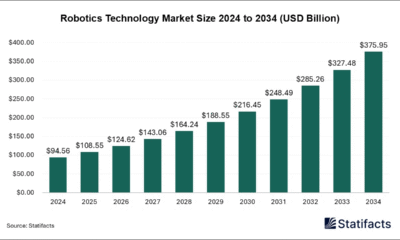Tools & Platforms
Google partners with Youngkin and offers AI training courses to Virginia job seekers

RESTON, Va. – Republican Gov. Glenn Youngkin announced on Tuesday that Google will partner with his administration to provide free and low-cost artificial intelligence certification courses to Virginians as part of his office’s ongoing effort to connect citizens to new jobs amid changes to the state’s economy.
The partnership, which he has described as an AI career launchpad, will provide Google-sponsored AI training courses for up to 10,000 Virginians at any given time, officials said at Google’s office in the northern part of the state.
The training opportunities will be listed on a job website that Youngkin launched earlier this year, in response to significant layoffs among federal workers by the Trump administration, including many workers from Virginia.
“All fields, all career movements somewhere along the way, are going to incorporate this next generation of technology,” Youngkin said at the news conference.
The initiative comes with unemployment rising in Virginia, which has roughly 20,400 continued unemployment claims, state Secretary of Labor George’ Bryan’ Slater said after the news conference. Roughly 2,800 people initially filed unemployment claims during the first week of July, which is about 6.1 percent higher than the previous week.
The AI webpage will feature the free courses as well as some low-cost learning opportunities, ranging “from beginner friendly courses on AI fundamentals and practical workplace applications of artificial intelligence to bootcamps and degree programs offered by Virginia’s leading-edge community colleges and universities,” according to the governor’s office.
Nicole Overley, commissioner of Virginia Works, said businesses have told her office that AI proficiency has become increasingly necessary in their industries. She said the training would help Virginians become competitive in the job markets where these very businesses are hiring.
Overly confirmed that the training courses won’t cost taxpayers anything and are being donated by Google. Bronagh Friel, head of partnerships at Google, said she was proud of the collaboration with the state.
“Google is committed to championing economic growth and opportunity in Virginia,” she said.
___
Olivia Diaz is a corps member for The Associated Press/Report for America Statehouse News Initiative. Report for America is a nonprofit national service program that places journalists in local newsrooms to report on undercovered issues.
Copyright 2025 The Associated Press. All rights reserved. This material may not be published, broadcast, rewritten or redistributed without permission.
Tools & Platforms
Live-translating AirPods are a glimpse into how AI will shape the future of work

People mostly yawned through Apple’s new product lineup unveiled this week. It’s hard to get jazzed about the two millimeters of pocket space reclaimed by the thinner model.
But live-translating AirPods are one of the more exciting and tangible uses of AI I’ve seen so far. They foreshadow AI that doesn’t just make things cheaper, but makes entirely new things possible.
The new AirPods are a concrete example of something I’ve had trouble envisioning, 18 months into this hype cycle. It’s easy enough to see the cost savings from AI as technology replaces humans. But by PWC’s estimate, two-thirds of AI’s contributions to global economic growth will come not from gains in productivity but from gains in consumption. In this vision, AI will spark the creation of more goods that people want to buy, and make them available to more people.
Railroads didn’t just reduce the cost of shipping goods; they opened the West. Fiber-optic cable didn’t simply make communication easier, but birthed the internet. Transformative technologies create bigger pies, not just cheaper ones.
Language barriers act as invisible tariffs on the global economy. They add friction to financial markets, artificially constrain talent pools, and leave money stranded on the wrong side of comprehension. Flip that switch, and suddenly every market becomes accessible, and good ideas trapped behind a language wall get unleashed. Goldman Sachs can deploy its sharpest minds in Brazil without Portuguese fluency. My failed hunt for custom blazers in Hong Kong last year can become a completed transaction. (Also: tips for next time, please.) Netflix’s “localization” model becomes possible for new industries.
There’s something dystopian about a world where everyone is sporting AirPods all the time, but I suspect the future is heavy on wearables anyway. The question is whether that hardware expands or merely entertains. Technology that opens up new avenues meets the hype in a way that AI replacing baby investment bankers or advertising studios just doesn’t.
Tools & Platforms
MissionHires is betting on AI to make recruiting faster, fairer, and more human

When Alfredo Vaamonde talks about the future of recruiting, he’s quick to clarify one thing: he doesn’t see artificial intelligence as a replacement for recruiters. Instead, he sees it as their partner.
“Our focus is to empower recruiters, not replace them,” Vaamonde told Refresh Miami. “That’s why our company is called MissionHires.”
The Miami-based startup, co-founded by Vaamonde and his wife, Mariana Escolar, automates up to 80% of the hiring process – from sourcing candidates to screening and initial engagement – so recruiters can focus on what matters: connecting with top candidates and making better hiring decisions.
For recruiting and staffing agencies, that efficiency translates into saved time and reduced costs. Instead of paying placement fees of 15–25% of a candidate’s salary, MissionHires offers flat-fee, retainer-based pricing.
“We’re quick, we’re focused on quality, and we’re very cost-efficient,” Vaamonde said.
The company has recently shifted its focus toward staffing and recruiting firms rather than only individual employers. That move has given MissionHires recurring business, with agencies using the platform month after month to support their teams. Healthcare companies and startups remain key clients too, but agencies now represent the biggest growth opportunity.
The technology itself is designed to be simple for recruiters to adopt. After posting a job description, the AI creates an ideal candidate profile, finds both active and passive candidates, and reaches out to them across email, text, or LinkedIn. When candidates respond, they go through a 15–20 minute chat-based interview, where the AI can collect text, audio, or video responses depending on the client’s preference. The system then generates a detailed report with skills, strengths, and any flagged areas for review. Recruiters walk away with a shortlist of pre-screened candidates, ready for live interviews.
“We’re taking the manual, repetitive tasks off their plate so they can be more efficient and place people faster,” Vaamonde explained. That means more time spent actually engaging candidates and less time slogging through inboxes and resumes.
Since launching in January, MissionHires has been averaging about $10,000 in monthly revenue. The team remains lean – just four people, including the husband-and-wife founding duo – but the vision is big. Vaamonde sees MissionHires as industry-agnostic, built to empower staffing agencies, recruiters, and hiring teams anywhere in the world.
That perspective is rooted in Vaamonde’s international experience. After spending the past two years living in Madrid with his family, he moved back to Miami this summer to double down on building MissionHires. The return has given him a fresh look at how much the city has changed since his last company, Papa, was founded here.
“In 2018, nobody was here,” he said. “We were actually pressured by YC to stay in San Francisco, but we chose Miami because this is where our clients were. Back then, there wasn’t really a tech ecosystem.”
Now, he said, Miami is buzzing with entrepreneurial energy. “Just in the past two weeks, I’ve had breakfast and dinner with founders who had moved here from New York and California. That didn’t exist five years ago.”
Still, Vaamonde sees room for growth. He’d like to see more founders born and raised in Miami leading startups. “Most of the entrepreneurs you meet here today are transplants,” he said. “We need more local talent building businesses from the ground up.” He believes universities and large companies will play a crucial role in fostering that next generation of Miami-grown founders.
Pictured above: Alfredo Vaamonde and Mariana Escolar, co-founders of MissionHires
READ MORE IN REFRESH MIAMI:
Tools & Platforms
Walmart’s bet on AI depends on getting employees to use it • The Register

At Walmart, “everybody’s using AI every day across the enterprise,” according to David Glick, senior vice president of the retail behemoth’s enterprise business services.
…it took a couple of years for the tools to get good enough, [to] hallucinate less, [to have] less bias, but also for us to get comfortable. And I think the beginning of this year was at the point where we started building agents
In a conversation on Wednesday with Atif Rafiq, founder of AI infrastructure startup Ritual, at the AI Infra Summit in Santa Clara, California, Glick explained that Walmart CEO Doug McMillon for the past few years has been pushing the company to go all-in on AI.
The hardest part of that transformation hasn’t been the technology. It’s been getting people to use it.
Glick recounted how a year ago at the same conference, he was preparing to go on stage and heard people in the preceding session talking about how the most challenging element of digital transformation is change management.
He explained, “I was standing in the back saying, ‘No, we’re engineering, and engineering does all the work. And that’s the hardest part, to actually write the code.’ And then as I thought about it throughout the day, I was like, actually, writing code, we know how to do that, and it’s getting easier and easier using AI. But it is, in fact, the change management.”
The issue in large companies, he said, is that everyone wants to be included, but “we’re moving people’s cheese” – in reference to a business leadership book on dealing with change.
To bring everyone along for the ride, Glick’s goal has been to make everyone use AI, not just software engineers.
“So the exciting part is not just engineers building things,” he said. “The engineers will build full enterprise-scale agents and whatnot. But every single person at Walmart is figuring out how to use AI in their jobs.”
Glick acknowledged that only 10 or 20 percent of Walmart’s associates – as employees are called – will do “vibe coding” or build software agents in their respective roles. But he suggested that AI tools are changing what Walmart looks for in its technical staff.
“Like when I was writing code, it was ‘Can you put the semicolon in the right spot?’ Or ‘Can you close parentheses every time you open them?'” Glick explained. “And then it was like, ‘Can you malloc() and free()?’ And then you’re like, ‘Oh, Java, you don’t need to malloc() and free() anymore.’ And now it’s like, I think, it’s curiosity, persistence, resilience, tenacity, and grit.”
Glick argues that the “the future belongs to the curious.”
He explained, “What we found is the people, whether they’re in the product team or the design team or the engineering team or the business team, the people who are succeeding most with AI are the ones who are most curious.”
His approach at Walmart has been to dive in and try things, to iterate rapidly.
“I’ve been at Walmart a little over two and a half years, and ever since I started, we’ve been talking about Gen AI and how we need to be a leader in Gen AI and Doug has told us he wants everybody using AI every day,” he said. “And it took a couple of years for the tools to get good enough, [to] hallucinate less, [to have] less bias, but also for us to get comfortable. And I think the beginning of this year was at the point where we started building agents.”
The approach Glick advocates is cross-functional, mixing the roles of developer, designer, and product manager. “I think we don’t even have a new vernacular for this,” he said. “We start with vibe coding and vibe designing and vibe PRD (product requirements document) and this and that.”
Is that a “viber”? he wondered. A designer? Even Glick’s own role appears to be fluid – he said he feels like the chief marketing officer of AI at Walmart.
Walmart’s AI bet has been accompanied by a change in the business processes needed to deal with AI. Glick said Walmart has 14 separate security processes, one of which involved compliance and had a backlog of weeks or months before projects would be approved.
“So we called the chief compliance officer and said, ‘Hey, if we can build an agent in a week, it can’t take you two months to approve our agent,'” Glick recalled. “And so she went in and built a new process. It’s still equally as safe. It leveraged AI and leveraged technology, but now the backlog is zero days instead of 60 days. So that is a great example of push, push, push, and see what we can automate.”
In terms of change management, Glick said, “I like to say we’re running projects with a stopwatch instead of a calendar now because we can turn these things while we sit with the business users. And so one of the things I’ve tried very hard is to go sit with the business users and show them what this can do because they don’t really have any concept. All they know is that IT is the bottleneck or tech is the bottleneck … In six months or in a year, tech will not be the bottleneck.”
Glick described his goal as empowering engineers to be able to take a laptop to a store or fulfillment center and, before they come home, to have built an agent or something that makes the lives of the associates in that facility better.
“We have lots of things that we’re trying to do,” he said. “We’re trying to grow revenue. We’re trying to cut costs. But if you can change people’s lives, that’s better than all that stuff.” ®
-

 Business2 weeks ago
Business2 weeks agoThe Guardian view on Trump and the Fed: independence is no substitute for accountability | Editorial
-
Tools & Platforms1 month ago
Building Trust in Military AI Starts with Opening the Black Box – War on the Rocks
-

 Ethics & Policy2 months ago
Ethics & Policy2 months agoSDAIA Supports Saudi Arabia’s Leadership in Shaping Global AI Ethics, Policy, and Research – وكالة الأنباء السعودية
-

 Events & Conferences4 months ago
Events & Conferences4 months agoJourney to 1000 models: Scaling Instagram’s recommendation system
-

 Jobs & Careers2 months ago
Jobs & Careers2 months agoMumbai-based Perplexity Alternative Has 60k+ Users Without Funding
-

 Podcasts & Talks2 months ago
Podcasts & Talks2 months agoHappy 4th of July! 🎆 Made with Veo 3 in Gemini
-

 Education2 months ago
Education2 months agoMacron says UK and France have duty to tackle illegal migration ‘with humanity, solidarity and firmness’ – UK politics live | Politics
-

 Education2 months ago
Education2 months agoVEX Robotics launches AI-powered classroom robotics system
-

 Funding & Business2 months ago
Funding & Business2 months agoKayak and Expedia race to build AI travel agents that turn social posts into itineraries
-

 Podcasts & Talks2 months ago
Podcasts & Talks2 months agoOpenAI 🤝 @teamganassi





















